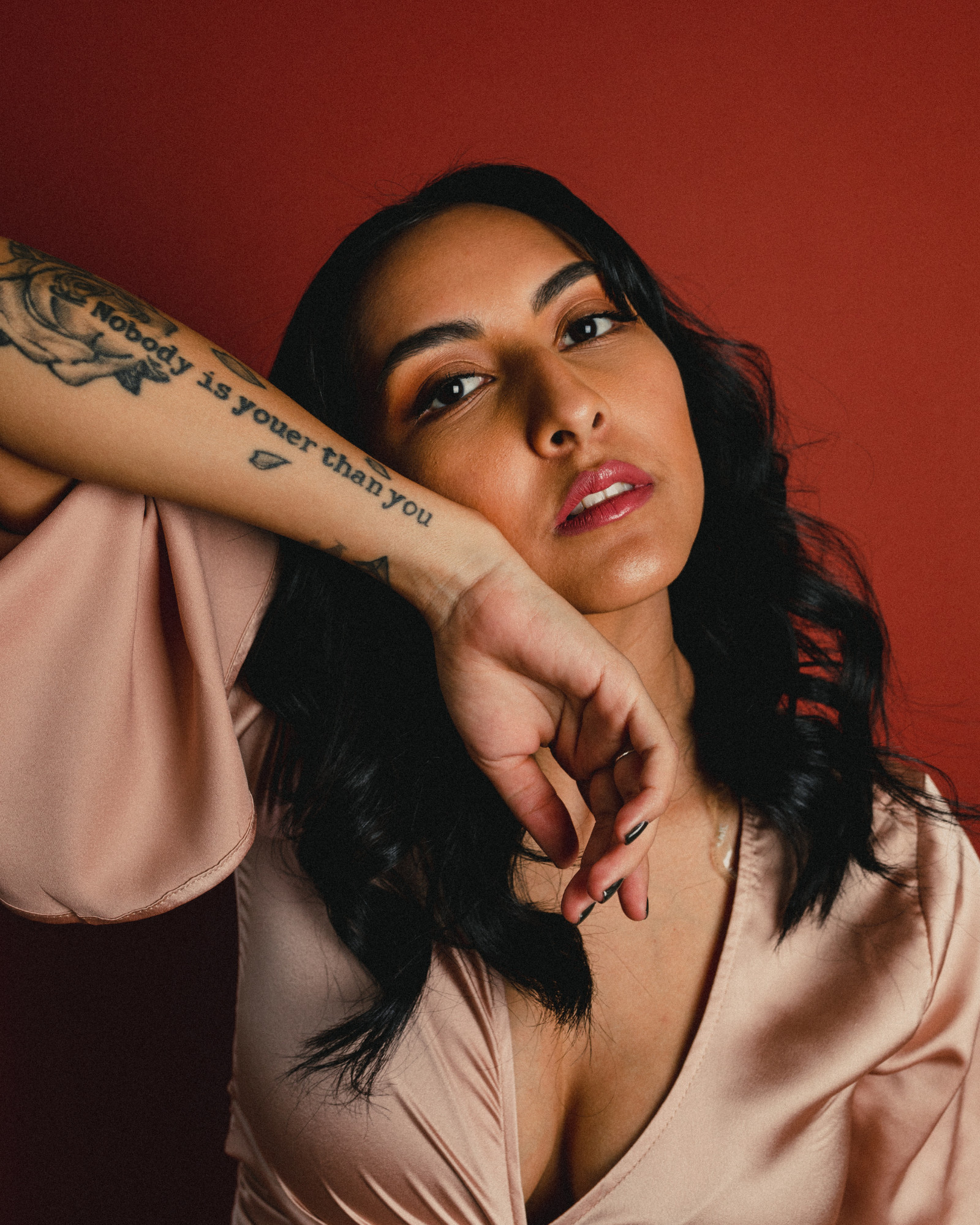Contemporary dance. You’ve heard the term, you might have seen it performed, or even taken a class. But what is it, really? My friend, a fellow dance instructor, sparked this very question when he described contemporary dance not as a standalone style, but as “a fusion of styles.” This idea is more common than you might think, prompting a deeper dive into the essence of contemporary dance. Is it a definitive genre, or something more fluid?
This question led me on a journey of discovery, seeking insights and perspectives to unravel the mystery of contemporary dance. And it turns out, my friend wasn’t alone in his thinking.
Tessandra Chavez, a two-time Emmy Award-winning choreographer, photographed in a dynamic contemporary dance pose.
Even prominent figures in the dance world, like two-time Emmy Award winner Tessandra Chavez, engage in ongoing debates about the nature of contemporary dance. “Contemporary dance isn’t codified; there isn’t necessarily a technique for it,” Chavez explains. “When you think of the word ‘contemporary,’ it means ‘current,’ and ‘now,’ so really, in itself, the word kind of means, ‘fusion.’”
This perspective is truly captivating and deserves closer examination. If contemporary dance isn’t a rigidly defined style, then what exactly is it? Where did it originate, and how is it continuing to evolve in the ever-changing world of dance?
Tracing the Origins: From Ballet Breakaway to Modern Movement
Fortunately, the roots of contemporary dance are well-established and documented. “Contemporary dance started in the twentieth century with Isadora Duncan,” Tessandra Chavez clarifies. Duncan was a revolutionary figure who sought “freedom from the structure of ballet, which is very black and white. You’re either right or you’re wrong; it’s very disciplined and structured.” Duncan’s rebellion was driven by a desire to expand the expressive possibilities of dance, “combining the emotional with the physical to drive the narrative even more than what ballet was able to do.”
This pivotal moment marked the birth of modern dance. It was, at its core, a deliberate departure from the strict confines of classical ballet, a powerful movement towards expressive liberation. Dancers shed their ballet slippers and embraced bare feet, grounding themselves in a more natural and unrestrained form of movement. Isadora Duncan’s pioneering spirit inspired a wave of influential figures, including Martha Graham, Lester Horton, Twyla Tharp, and Merce Cunningham, among many others. Modern dance developed a rich history and a distinct movement vocabulary. The subsequent blending of modern dance principles with ballet and jazz techniques paved the way for the contemporary movement as we recognize it today.
The contemporary dance that resonates with many audiences today gained significant mainstream recognition through shows like FOX’s “So You Think You Can Dance.” This popular television program is arguably responsible for solidifying “contemporary” as a recognized dance style in the public consciousness. Mia Michaels, an Emmy Award-winning choreographer for her work on the show, is widely acknowledged as a key figure in shaping contemporary dance’s modern evolution.
Talia Favia, a respected contemporary choreographer and educator, had the unique opportunity to train under Mia Michaels during this transformative period. “She had created this new age and new way of expressing movement through pure emotion,” Talia recalls. “Watching her pull from all these different styles, she just understood this full culmination. Anyone in the room creating with her at that time knew that we were creating history. It really was just things we had never seen before.”
Since its breakthrough on “So You Think You Can Dance,” contemporary dance has permeated various aspects of popular culture, from dance studios and music videos to advertising campaigns, films, dance conventions, and educational settings. It has been widely embraced and actively practiced across the globe.
“My generation was able to witness that whole transformation,” Talia Favia reflects. “It was so new and so exciting. It brought forth not only contemporary dance, but a new way to do it that every average person could relate to. To see it received so well from the masses was the moment that things got real and we felt understood. It was relatable.”
Defining Contemporary: An Emotional and Expressive Playground
“What Is Contemporary Dance?” Talia Favia poses the fundamental question. “That’s such a question that I don’t know if anyone can really answer it. It’s so different to everyone, and I think each style of contemporary thinks that their style is ‘the one.’ But I think that’s exactly what contemporary should be!”
Echoing Tessandra Chavez’s earlier point, contemporary dance lacks codification. Unlike ballet or jazz with their established techniques, or hip hop with its distinct cultural history, contemporary dance doesn’t adhere to a rigid set of rules. So, how do we begin to define it?
 MaryAnn Chavez contemporary dance instructor
MaryAnn Chavez contemporary dance instructor
MaryAnn Chavez, choreographer and co-founder of Lume Dance, pictured in a studio setting, embodying the fluidity of contemporary dance.
MaryAnn Chavez, choreographer and co-founder of “Lume Dance,” who has extensive experience teaching contemporary dance, offers her perspective: “I believe that contemporary is a playground for all styles of dance to meet in the middle. There’s so many different forms of contemporary dance. Ballet training, jazz training, and lyrical training may play a part in it!”
Observing a contemporary dance piece, you’ll likely notice a diverse range of techniques. You might see both flexed and pointed feet, shifts in rhythm, and varied movement textures. This eclecticism underscores the importance of training in and researching other dance genres. “In order to do contemporary well, you have to study and try to master ballet, jazz, modern, hip hop, tap even, because of the musicality,” emphasizes Tessandra Chavez. “It isn’t something you can just mock and imitate and pretend to do. Those of us who actually have studied in those root genres can actually see in a dancer all the holes and the things that they lack from a standard of mastery or excellence.”
Beyond technique, another crucial aspect of contemporary dance is its emotional depth. For audiences, this emotional resonance is often the most impactful element. “First and foremost, I would say contemporary is the most emotional type of dance,” asserts Talia Favia. “There’s a communication factor. I feel I am best understood as a person, through movement. I get to truly say what I’m trying to say and make it as clear as possible.”
Tessandra Chavez concurs, highlighting contemporary dance’s unique power to connect with viewers on an emotional level. “For whatever reason, a non-dancer can sit at home and watch a contemporary dance and feel something!” she observes. “They may not know why they feel it, but there’s clearly a story being told that’s usually a universal one that makes you feel seen and inspired!”
The Evolving Landscape: Contemporary Fusion and the Future
True to its name, contemporary dance remains in a constant state of evolution. You might increasingly encounter classes and performances labeled “Contemporary Fusion.” But considering that contemporary dance is already described as a fusion, what does “fusion” in this context truly signify?
Tessandra Chavez clarifies this emerging subgenre: “I consider Rhapsody James from the East Coast and even myself from the West Coast, and Wade Robson as pioneers of this style called ‘contemporary fusion.’ People now understand contemporary fusion as ‘the intricate contemporary.’ The ‘one-ee-and-a-two’ that is still emotive and technical in that.”
MaryAnn Chavez adds that this evolution often draws from diverse movement vocabularies. “I would say contemporary fusion implements more street styles,” she explains. “It’s more about the musicality and movement quality. We might contort our body in a different way than you would see in a commercial or hip hop class.”
Talia Favia, contemporary choreographer and educator, captured in a moment of artistic reflection, embodying the innovative spirit of contemporary dance.
This fusion implies that contemporary dance is becoming increasingly accessible, welcoming dancers from various training backgrounds and movement styles. The future of contemporary dance appears vibrant and limitless. “I think about this all the time,” Talia Favia shares. “I really hope that contemporary can find its way to becoming a fundamental art form. A fundamental thing that everyone needs to have, because it’s so crucial in so many ways!”
“I think it’s going to continue to evolve as people explore,” Tessandra Chavez predicts. “Dancers now are taking everything that they have in their toolboxes, and I see them mastering it even more than I have and just really stretching their wings and flying with it! I see it becoming more masterful! I see people exploring more and finding more creative ways and textures to emote!”
Your Unique Contribution: Embracing Personal Style in Contemporary Dance
A significant aspect of contemporary dance’s appeal lies in its inherent lack of rigid boundaries. While this fluidity can make defining it challenging, it also empowers individuals to approach contemporary dance in a way that genuinely reflects their personal style and unique background.
“There’s a lot of different ways that contemporary can be taught,” Talia Favia points out. “You know if you’re doing a math problem, and your dad learned math a different way than your mom learned math–the process is different, but the ending result is still correct. That’s how I’ve been able to wrap my head around this subject of so many different types of contemporary. Where do we even begin to differentiate them?”
The unifying thread is that your individual history, your foundational training, and your artistic sensibilities are integral to shaping what contemporary dance is and what it can become. The basis lies in understanding the guidelines established by other dance styles, learning them, and then intentionally breaking them to find your own voice. “You are uniquely you, and leaning into that more is what’s going to set you apart,” MaryAnn Chavez encourages. “Ask questions, be open-minded, and come in with an intention, because you dance for yourself.”

